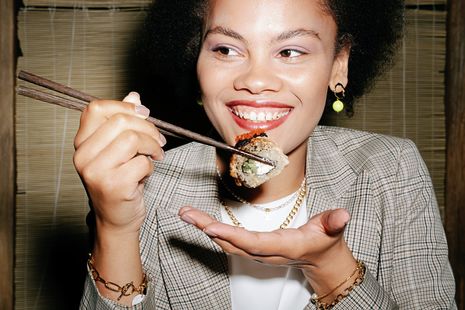You (wear) what you eat: When food meets fashion
From meat dresses to pizza memorabilia, when food and fashion get together it’s bound to get messy

VMAs. 2010.
‘Hold my meat purse’.
Lady Gaga steps onto stage in a dress of raw flesh. Whether frivolous or political, the moment cemented her celebrity status and brought to boil tensions between ethics and aesthetics, and our all-consuming obsession with food and fashion. Between the “I love pizza” t-shirts and the picture-perfect pancakes on your feed, food is fashion. And fashion is always political.
As food becomes increasingly permanent through the museum of social media, and fashion increasingly transient, both feed into and off a visceral nostalgia. Circling through trends at alarming rates, the two sensory experiences come to represent both memory and a cultural moment. Marcel Proust remembers his childhood through the madeleine that he soaks in tea, while outfits increasingly become a way of returning to personal and social history: the dress you never wear but won’t throw away because it reminds you of being 17, the skirt that screams sixties mod. Recent y2k and 70s revivals present a return to familiar styles, while a growing market offers ‘the sweets you ate as a child’ neatly tied up into one bulk-bought culinary experience. “I think you have links when it comes to trends, our cultural tastes, and our cultural appetites,” says Melissa Marra-Alvarez, editor of Food and Fashion and curator of a recent exhibition on the topic: “There are also these intimate connections with nostalgia between fashion and food.” The two are steeped in personal experience. Food is more than fuel, and clothes more than a cover-up.
“Jennifer Lawrence is heralded as a woman of the people for eating pizza at the Oscars”
In a recent collaboration with McDonalds, Finnish fashion brand Vain released a series of haute-couture workwear. Crafted from up-cycled workwear into slick black belts and clean-cut jackets, the collection is marked with a familiar yellow M. Yet the outfits are not aimed at employees. Fast food is only fashionable when it is adopted by the rich. Shorthand for class, culture, and gender, the relationship between food, fashion and identity is muddied. To choose what you eat and wear is to forge yourself within a globalised system of labour and exploitation, as well as marketing. Donald Trump woos voters by buying McDonalds for first responders in Ohio; Chipotle has paired up with the likes of Shawn Mendes, Miley Cyrus and Twenty One Pilots to drive sales; Jennifer Lawrence is heralded as a woman of the people for eating pizza at the Oscars. Increasingly, celebrity culture and brands pair fast food and haute couture in an obvious attempt at relatability. Yet it comes across as nothing more than class cosplay.
While Lady Gaga’s raw flesh awards dress might have horrified, its implications go beyond our visceral response. Human bodies and meat bear an uncomfortable relationship, one which we strive to ignore. The meat industry packages its food as anonymous slabs, attempting to distinguish living beings from consumable goods. Cows, pigs and sheep are repackaged as beef, pork and mutton, a linguistic distinction which dates back to the Middle English use of French to distinguish the peasantry’s livestock from the court’s cuisine.
“‘Looking good enough to eat’ becomes a twisted compliment”
Wearing animals highlights a strange blurring of flesh, food, and fashion. Artist Jana Sterbak’s ‘Vanitas: Flesh Dress for an Albino Anorectic’ (1987) explores the sexualisation of women by dressing its model in fresh meat, while questioning the implications of the ‘Vanitas’ trend in art: one which serves to both shame women for vanity while providing the spectator uninhibited viewership. A lineage of ‘meat-suits’ challenges the aesthetics of consumption and how we both inhabit and appropriate bodies. Exemplified by The Undertones’s 1983 album cover (a woman dressed in sausages and salami), women are packaged as meat, wrapped and ready to devour. ‘Looking good enough to eat’ becomes a twisted compliment. Be it the 1970s Milk Tray Man, Love Moschino’s Hershey wrapper dress or the scandalous desexualisation of the green M&M; food, fashion and the feminine body are mashed uncomfortably together.
Ultimately, while the relationship between food, fashion, trends and aesthetics speaks to a human impulse towards art and innovation, it also becomes enmeshed in a capitalist ideology. Clothing and food cannot exist outside of their relationship to the consumer, yet the consumer is equally dependent. What we are fed and what we wear informs both how we are seen and who we become. Beyond mere means of survival, they are wrapped up in how we define ourselves.
Recent shifts towards sustainable style and conscious cooking (through thrifting and upcycling, buying local and alternative diets) seek to redress our attitudes towards waste. Nonetheless, these movements remain at the fringes of our consumption, wearily regarded as attacks on a culture we cannot sustain. From ethical statements to social media fuel; climate activism to erotics; what we eat and what we wear become the very tools through which we fashion ourselves.
 Features / Should I stay or should I go? Cambridge students and alumni reflect on how their memories stay with them15 December 2025
Features / Should I stay or should I go? Cambridge students and alumni reflect on how their memories stay with them15 December 2025 News / Cambridge study finds students learn better with notes than AI13 December 2025
News / Cambridge study finds students learn better with notes than AI13 December 2025 Comment / The magic of an eight-week term15 December 2025
Comment / The magic of an eight-week term15 December 2025 News / Dons warn PM about Vet School closure16 December 2025
News / Dons warn PM about Vet School closure16 December 2025 News / News In Brief: Michaelmas marriages, monogamous mammals, and messaging manipulation15 December 2025
News / News In Brief: Michaelmas marriages, monogamous mammals, and messaging manipulation15 December 2025









